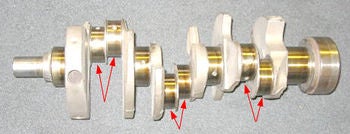am incercat sa editez, desi a mers sa dau edit la sfarsit a expirat impul deci propun ca imbunatatire a formului, daca un user reuseste sa dea in timp util edit la un post sa mearga editarea indiferent daca procesul de editare dureaza 4 zile.

pls wake up ness!
ps:
eu nu vreau sa intru in polemica cu valak, pentru ca in primul rand cand intri cu cineva in discutie trebuie sa ai cu cine!
o sa incerc sa explic simplu, sa inteleaga toata lumea:
La V6 cu 120 de grade intre cilindri arborele este normal, adica cum il stie toata lumea, motorul este echilibrat atat cat ai permite acea configuratie, oricum nu e nimic serios de el si iese si ca un boxer deci solutia a fost v6 la 60 de grade care merge cat de cat ok.
Acum de ce 90, pai foarte simplu, se ia un bloc de V8 care vine la 90 grade, se scot doi cilindri si iata ca se obtine o platforma de V6 cu niste costuri mai mici, logic. Buba apare la arbore, pentru a fi aliniat ca cel de 120 grade, se "rupe" arborele intre biele adica se deplaseaza putin si astfel motorul simuleaza ceea ce ar fi un V6 de 120.
bineinteles multi o vor da in centre de greutate, in raciri, de cand pasa alfei romeo de racire, uitati va unde sta alternatorul la alfa din batatura

, dar de data aceasta asa e, au facut totul perfect si cel mai bine din lume pentru ca nu i asa, a zis domnii ingineri de seara

o sa pun poze cu arborii normali si cei split:
multi sustin ca arborii split nu rezista asa bine si cedeaza, adica au o rata de failure mai mare, teoretic asa este :

un arbore normal:

chiar si mercedes a renuntat la V6 de 90 pentru ca motorul nu era fiabil, avea multe piese in miscare , arbori balansieri, arbori care trebuiesc miscati ghici cu ce? cu lantul sau cureaua de distributie si astfel in timp aparareau probleme, arbori de etansat, distributii de dimensionat, idlere, alte panarame.
wiki:
"90 degrees[edit]
Many manufacturers, particularly American ones, build V6 engines with an angle of 90 degrees because such configurations were created removing two cylinders from existing V8 engine design. This reduces design costs, allows them to share components with the V8, and possibly allows them to be built on the same production line as V8s.
Although it is relatively easy to derive a 90° V6 from an existing V8 design by simply cutting two cylinders off the engine, this tends to make it wider and more vibration-prone than a 60° V6. The design was first used by Buick when it introduced its 198 CID Fireball V6 as the standard engine in the 1962 Special. Other examples include the Maserati V6 used in the Citroën SM, the PRV V6, the Rover KV6 (2.0- and 2.5-litre),
MG Rover groups KV6 engine
the Honda C engine used in the NSX, Chevrolet's 4.3 L Vortec 4300 and Chrysler's 3.9 L (238 in3) Magnum V6 and 3.7 L (226 in3) PowerTech V6. The Buick V6 was notable because it introduced the concept of uneven firing, as a result of using the 90° cylinder bank angle and shared-crankpin crankshaft design found in the V8 engine (although the V6 crankshaft does have 3 crank throws set at 120° apart, rather than 90° apart as found in the V8) . Rather than firing every 120° of crankshaft rotation, the cylinders would fire alternately at 90° and 150°, resulting in strong harmonic vibrations at certain engine speeds. These engines were often referred to by mechanics as "shakers", due to the tendency of the engine to bounce around at idle speed.
More modern 90° V6 engine designs avoid these vibration problems by using crankshafts with offset split crankpins to make the firing intervals even, and often add balancing shafts to eliminate the other vibration problems. Examples include the later versions of the Buick V6, and earlier versions of the Mercedes-Benz V6. The Mercedes V6, although designed to be built on the same assembly lines as the V8, used split crankpins, a counter-rotating balancing shaft, and careful acoustic design to make it almost as smooth as the inline-6 it replaced. However, in later versions Mercedes changed to a 60° angle, making the engine more compact and allowing elimination of the balancing shaft. Despite the difference in V angles, the Mercedes 60° V6s are built on the same assembly lines as 90° V8s.[12]"